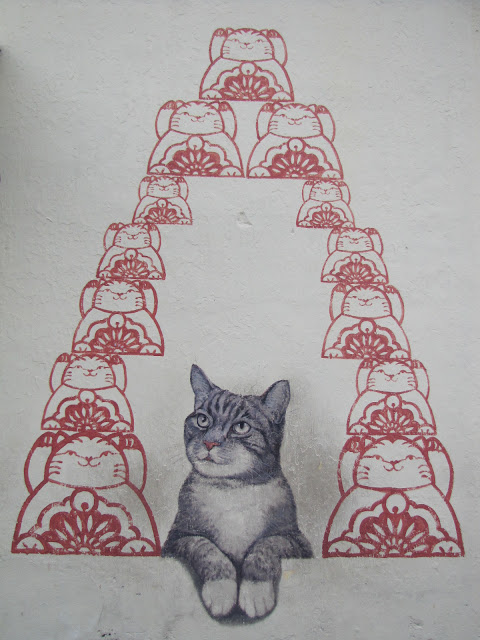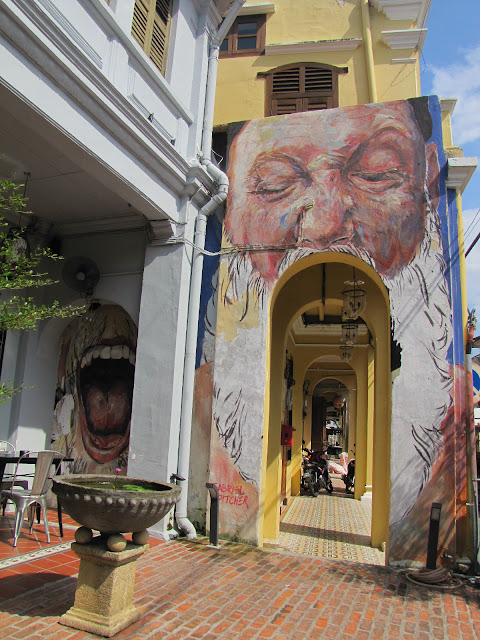Day 1 in Penang: Street Art & Khongis
Good vegetarian food, cheap beer, extensive street art, exciting architecture, cool museums, laid back venomous snakes and cheeky non-venomous monkeys. These are a few of my favorite things. At least, I think that is how the song goes. Or better yet, that is a rundown of a few of the things I loved about the kick-ass island of Penang.
As I have mentioned before, I purposely did very little research prior to this trip. Therefore, it came as the most welcome of surprises when, after an 8 hour bus ride, I checked into my hostel and was handed both a city map and a street art map. There was enough street art to warrant its own map! This was looking promising.
My hostel, the excellent Magpie Residence, was about a fifteen minute walk from the heart of Georgetown (or a free bus ride away) so the first evening I only explored a bit of the outskirts of town.
And even better, for a clueless tourist such as myself, all over the city there were wire sculptures explaining the history of the city.
Excited about all there was to see, I set off early the next morning to explore what was already my favorite city in Malaysia. My goal was to try to see all the murals listed on the map. Looking back, there may have also been a subliminal goal at play, which was to take the greatest number of photos that my battery and memory card would allow.
I was not alone in my photo frenzy but one thing I found really kind of sweet was the amount of interaction that the murals encouraged. These were not works of art meant to be admired from afar. Many featured a 3D element that brought people into the work itself.
Also, at a time when it seems like the line between street art and commerce is becoming more and more tenuous- the art district by my home now boasts murals promoting Mountain Dew, Oculto beer and some brand of coconut water!- everything I saw seemed so much more organic and unforced.
I could have finished the art walk and called it a day but then I would have missed out on one of the main reasons that Georgetown was dubbed a UNESCO world heritage site. Back in the 19th century, Chinese businessmen were accumulating great wealth by engaging in multiple enterprises (read: trade, opium, gambling, et al), leading more of their countrymen to migrate over. The most powerful families set about building their own clan houses, or kongsi, to both welcome the newcomers and to show everyone how well off they were. The more ornate the kongsi, the more you were big pimpin'.
Many families did this but no one rolled harder than the Khoos. I did not know this at first. Upon entering Khoo Kongsi through a pretty nondescript alleyway, I thought that I had wasted the 10 ringgit (approx $2.50) entry fee. The temple I saw was nice but not that different from the many others that I had seen for free throughout the city.
And then the alley opened up into a courtyard and I turned around. A very loud "Holy Fuck!" escaped my lips. This was not so much a clan house as a clan village and the main building was AMAZING.
Every square inch was expertly carved, gilded, adorned and embellished. I must have spent over an hour just admiring the exterior. Each time I turned around, I spotted some detail that had been overlooked the prior time around. It really was breathtaking.
Even back then, one thing was certain, haters were gonna hate. The rivalries between the clans were often intense as was the competition for business. In 1867, a ten day riot broke out between the clans, during which the Khoos took to firing cannon balls at their enemies in the middle of this very compact city.
My next visit was to the home of another high roller, Cheong Fatt Tze. His was not so much a clan house as a "I'd better keep my 7th wife, who happens to be 50 years younger than me happy" house. Throughout the included tour, we learned about Fatt Tze's rags to riches story and how he tended to expand his business empire by marrying prominent women in whatever country he was hoping to tap into. Out of his 8 wives, #7 was his favorite (although not so much so to preclude a #8). Fatt Tze (who, let's face it, has the perfect rapper name) was 70, she was 20 and true love conquered all.
That and a gorgeous home, that was influenced heavily by the principles of feng shui. Following Fatt Tze's death, it was allowed to decay to ruin but a careful restoration placed it on Lonely Planet's list of top mansions in the world. In addition to a museum, it now doubles as a high end hotel and conference center.
By this point in the day, I happened to check my phone's pedometer. In my quest for street art and a taste of the city's history, I had logged over twelve miles.
There was still plenty of Penang to see but with another full day there, I didn't want to peak too early. Best to grab some tofu curry, hit a laid-back bar and get some rest. The snakes and monkeys awaited.
As I have mentioned before, I purposely did very little research prior to this trip. Therefore, it came as the most welcome of surprises when, after an 8 hour bus ride, I checked into my hostel and was handed both a city map and a street art map. There was enough street art to warrant its own map! This was looking promising.
My hostel, the excellent Magpie Residence, was about a fifteen minute walk from the heart of Georgetown (or a free bus ride away) so the first evening I only explored a bit of the outskirts of town.
But that was enough to start getting a taste for the combination of history and art that is Penang. There were ancient buildings sitting side by side with freshly painted murals.
And even better, for a clueless tourist such as myself, all over the city there were wire sculptures explaining the history of the city.
Excited about all there was to see, I set off early the next morning to explore what was already my favorite city in Malaysia. My goal was to try to see all the murals listed on the map. Looking back, there may have also been a subliminal goal at play, which was to take the greatest number of photos that my battery and memory card would allow.
I was not alone in my photo frenzy but one thing I found really kind of sweet was the amount of interaction that the murals encouraged. These were not works of art meant to be admired from afar. Many featured a 3D element that brought people into the work itself.
 |
| If not for these info-sculptures I would have never known that Jimmy Choo, favorite shoemaker to women with too much disposable income, is from Penang. |
Also, at a time when it seems like the line between street art and commerce is becoming more and more tenuous- the art district by my home now boasts murals promoting Mountain Dew, Oculto beer and some brand of coconut water!- everything I saw seemed so much more organic and unforced.
 |
| I like to think there were two artists involved with this, one who was a Bruce Lee fan and another who was a jokester that preferred turning Lee into a kitty kicking coward. |
I could have finished the art walk and called it a day but then I would have missed out on one of the main reasons that Georgetown was dubbed a UNESCO world heritage site. Back in the 19th century, Chinese businessmen were accumulating great wealth by engaging in multiple enterprises (read: trade, opium, gambling, et al), leading more of their countrymen to migrate over. The most powerful families set about building their own clan houses, or kongsi, to both welcome the newcomers and to show everyone how well off they were. The more ornate the kongsi, the more you were big pimpin'.
Many families did this but no one rolled harder than the Khoos. I did not know this at first. Upon entering Khoo Kongsi through a pretty nondescript alleyway, I thought that I had wasted the 10 ringgit (approx $2.50) entry fee. The temple I saw was nice but not that different from the many others that I had seen for free throughout the city.
Every square inch was expertly carved, gilded, adorned and embellished. I must have spent over an hour just admiring the exterior. Each time I turned around, I spotted some detail that had been overlooked the prior time around. It really was breathtaking.
 |
| This insanely detailed painting in the back of the temple is called "The Nine Old Men" and honors the leader of the Khoo clan for navigating both the yin and the yang, the past and the present. |
Even back then, one thing was certain, haters were gonna hate. The rivalries between the clans were often intense as was the competition for business. In 1867, a ten day riot broke out between the clans, during which the Khoos took to firing cannon balls at their enemies in the middle of this very compact city.
My next visit was to the home of another high roller, Cheong Fatt Tze. His was not so much a clan house as a "I'd better keep my 7th wife, who happens to be 50 years younger than me happy" house. Throughout the included tour, we learned about Fatt Tze's rags to riches story and how he tended to expand his business empire by marrying prominent women in whatever country he was hoping to tap into. Out of his 8 wives, #7 was his favorite (although not so much so to preclude a #8). Fatt Tze (who, let's face it, has the perfect rapper name) was 70, she was 20 and true love conquered all.
By this point in the day, I happened to check my phone's pedometer. In my quest for street art and a taste of the city's history, I had logged over twelve miles.
There was still plenty of Penang to see but with another full day there, I didn't want to peak too early. Best to grab some tofu curry, hit a laid-back bar and get some rest. The snakes and monkeys awaited.
























































Comments
Post a Comment